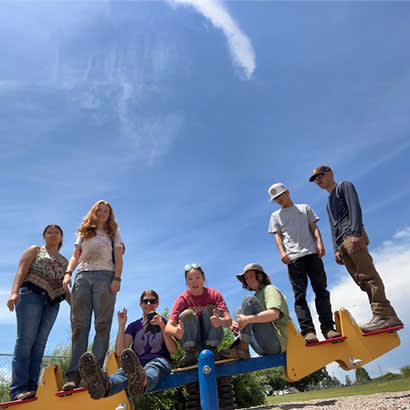
Pictured: A crew of youth and young adults who help care for Rio Fernando Park in Taos, New Mexico. Photo courtesy of Taos Land Trust.
Spring in Taos is a beehive of activity. Snowmelt from New Mexico’s tallest mountains begins to swell the streams and creeks that wind their way into town. Landowners pull out their shovels and rakes and gather to begin cleaning our acequias, centuries-old irrigation ditches that carry water, culture and tradition into fields. Just as we think it’s warm enough to put seeds in the ground, we get a late-season snowstorm that reminds us that nature is in charge. We shrug and enjoy getting to start another fire in the woodstove and making another pot of green chile stew.
Rio Fernando Park is a 20-acre microcosm of our area’s connection to water, land, people and food. Taos Land Trust was gifted the funds to save the property from massive development, and has, in turn, gifted the open space to our community. We are a small staff and the three of us would not be able to care for the park without the help of a seasonal crew of youth and young adults, ages 14-25, who roll up their sleeves day after day and maintain trails and gardens, build benches and friendships, and learn critical life and work skills along the way.
Our crew is funded through a Youth Conservation Corps (YCC) grant awarded by the state of New Mexico. We have been recipients of this grant going on eight years now, and we have been able to employ upwards of 100 crew members. We recruit primarily from our area and offer a starting wage of $16 an hour.
What we do is more than just work. In fact, work is not even the end result. Work is really the pathway to a goal of inspired future stewards of our public lands and open spaces. Taos Land Trust staff and others provide training in teamwork, leadership, wilderness first aid, CPR, soil health, ecological monitoring, conservation principles, civic engagement and the agricultural history of northern New Mexico. Our workers support the broader community, too; every other Wednesday they show up to help distribute food to hundreds of community members at a local food bank.
Our crew members come from different backgrounds. Many are tribal or legacy Hispanic. Others are newer to the community. Many have never helped plant a home garden or spent much time outdoors. Some are interested in pursuing careers in conservation or land management. Others have just heard that it’s a fun summer job with cool staff. We do interview our applicants, but our primary focus is on finding individuals who are eager to show up and learn.
When they get their hands dirty turning over soil and planting corn, beans and squash in one of our gardens, crew members are learning the importance of local food systems. When they are repairing a section of trail, they are learning how to use hand tools and maybe even a tractor. They are also learning that outdoor spaces need to be accessible for all, and that outdoor recreation and conservation can be a career path. They’ve also seen firsthand the impact that climate change is having on streams, lands and communities.
As spring turns to summer and then fall and the season wraps up, we gather to harvest and feast. We harvest potatoes, chickpeas, corn, beans, squash, tomatoes, kale, friendships and memories. Our crew members come inside our small adobe-turned-office. They again roll up their sleeves — this time to wash their hands — and they learn how to turn the fruits of their harvest into bread and soups and salads. We sit down together at our kitchen/conference table and share a meal.
Afterwards, we go down to the river. I teach a few how to fly fish; others just want to wade in the cool waters or read a book in the shade. Either way, these young people have spent a season outside in a community and a world that doesn’t always do a good job of saying that outdoor spaces and recreation are for everyone, and they have learned that these outdoor spaces do indeed belong to all.
We thank the crew members for their season. Some are back in high school. Others are off to college. In the coming months they stop in, say hi, and take loved ones on a walk around the park. Our staff takes time off from grant reporting and billing to chat.
We’ve witnessed remarkable changes and growth among these young people. Staff have changed and grown alongside them. Together, we’ve grown the community that will help care for open spaces and public lands for years to come. Together, we are changing the face of conservation and land management.
Winter comes and it’s a snowstorm of activity as we prepare for the next crew. We plan projects, line up trainers and schedule interviews. Sometimes we take time off and ski, but our mission is never too far from our minds.
Darien Fernandez is the executive director for Taos Land Trust.
Taos Land Trust is part of NRPA’s Workforce Development Community of Practice, a program funded by the Department of Labor through Advancing Workforce Development and Career Readiness Through Parks and Recreation Funding Opportunity FOA-ETA-23-06: Workforce Pathways for Youth.
This blog post is part of a multi-part virtual learning series highlighting park and recreation workforce development programs across the country. For more stories like this, check out “Recreation as a Gateway to Youth Workforce Development,” highlighting a program in Washington, D.C., and “Empowering At-Risk Youth Through Workforce Development in Recreation,” highlighting a program in Archer Lodge, North Carolina.


